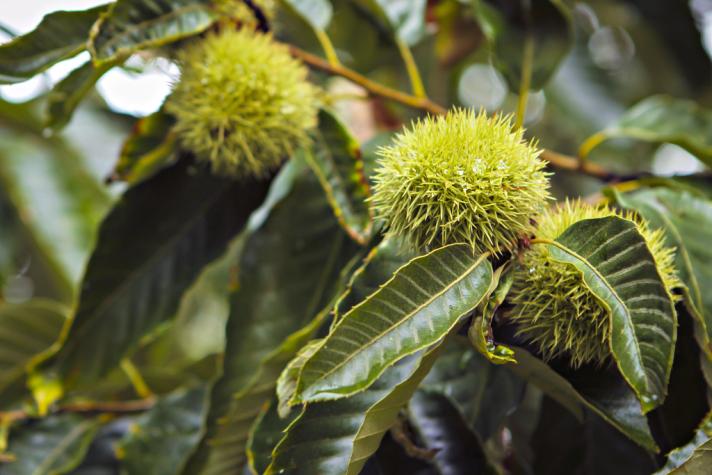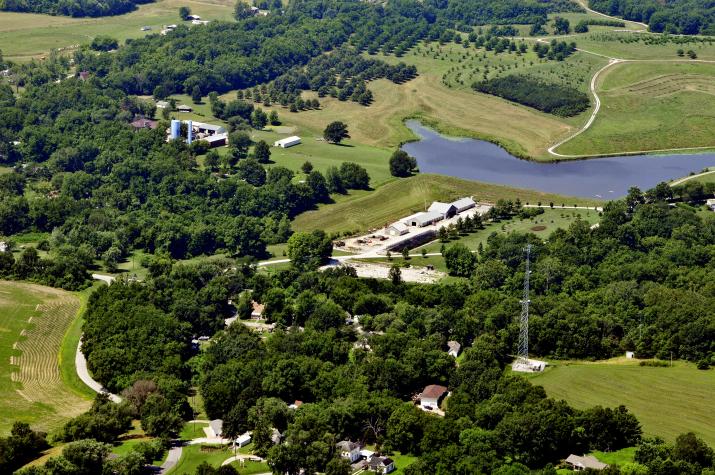Chestnuts are a lucrative crop for family farmers
COLUMBIA, Mo. – Missouri river hills would look beautiful lined with chestnut trees and they’d turn a pretty profit.
“Missouri has a lot of acres in the river hills, which are fertile, deep, well-drained soils perfect for growing chestnuts,” said Michael Gold, professor of forestry at the University of Missouri.
“If you manage a 50-acre orchard you can produce 100,000 pounds of chestnuts,” Gold said. “And even at the lower end of the wholesale prices for chestnuts, that’s $200,000 (gross) for the family farm.”
Gold, associate director of the MU Center for Agroforestry, says that since 1996 the center has been building a body of research designed to increase chestnut production in the state. Everything from the cost breakdown for establishing 50 trees on a single acre to a grower’s calendar, and even guides and brochures to help producers market chestnuts.
The MU College of Agriculture, Food and Natural Resources’ Horticulture and Agroforestry Center (HARC), in New Franklin, Missouri, researches alternative crops for family farms. Small to medium-size farms don’t have enough acres to grow corn or soybeans competitively. Gold says you don’t need thousands of acres to be a major chestnut producer.
“Fifty acres of corn, you’re a garden. Fifty acres of chestnuts, you’re in big business,” Gold said. “If you had a 50-acre orchard, by the time the trees are 12 years old you’ve got 100,000 pounds of chestnuts a year.”
There’s a growing market eager to buy chestnuts as fast as they can be grown.
“There’s not only demand, but those individuals who are serious about chestnut production cannot keep up with the demand. Their crops are sold out as soon as they’re harvested,” Gold said.
The chestnut market goes beyond just raw nuts. Gold says there are many value-added products that can be made from chestnuts.
For example, chestnuts can be dried and ground into gluten-free flour. There’s a brewery in St. Louis that produces chestnut-flavored beer. Gold says there are chestnut liquors, sweetened puree, gluten-free pancake mixes and marron glace, a candied chestnut popular in France and Italy.
Cooking with chestnuts is gaining in popularity too. You can add roasted chestnuts to pasta, vegetables and grain dishes, Gold said. They can be made into a puree and spread on crepes and pancakes. Whole chestnuts can be used to thicken soups and stews.
Today, consumers are more interested in what they eat and where it comes from. “The National Restaurant Association’s ‘What’s Hot in 2014’ has locally grown, gluten-free cuisine and environmentally friendly foods in the top five trends,” Gold said. “Missouri chestnuts meet all three.”
There’s more to chestnuts than roasting over an open fire. Gold says chestnuts are called the “un-nut” because they are very different from their tree-nut cousins.
“They’re 99-percent fat-free, gluten-free, cholesterol-free and have as much vitamin C as an equal weight of lemons,” he said.
Right now it’s a seasonal nut, but the more people are exposed to chestnuts, the more they will buy them, Gold said. In Europe, especially Italy, chestnuts are celebrated in the fall just as Americans celebrate pumpkins. If chestnuts become as popular here as they are in Europe, they will easily move from just a holiday treat to standard fare.
For that to happen, we need chestnut producers. The United States lost ground when blight destroyed the American chestnut in the first half of the 20th century. Today, the Chinese chestnut is becoming an increasingly important crop in several states, including Michigan and California. But Missouri is perfectly poised to become the top chestnut producer in the country, Gold said. All we need are family farmers willing to plant the trees on their river hill acres.
For more information, go to MU Center for Agroforestry and Horticulture and Agroforestry Research Farm.
Carolina Chestnut Pork
Recipe from Executive Chef Eric Cartwright, University of Missouri
For the pork:
- 1 each bone-in Boston butt, about 8 pounds
- 3 tablespoons kosher salt
- 3 tablespoons ground black pepper
For the sauce:
- 1 cup apple cider vinegar
- 6 tablespoons ketchup
- 6 tablespoons water
- ½ cup chestnut meat, well-roasted
- 2 ½ teaspoons sugar
- ¾ teaspoon kosher salt
- ¼ teaspoon crushed red pepper
- Combine all of the sauce ingredients in a blender and blend until smooth. Place in the refrigerator for at least 24 hours so the flavors can blend.
- Season pork on all sides with salt and pepper. Prepare a smoker or charcoal grill for low-temperature (220-245 degrees F) cooking. Place the seasoned pork on the smoker or grill and add wood chips and/or chestnut shells to the coals. Slow cook for eight to 10 hours or until the meat has reached 195 F internal temperature and has begun pulling away from the bone.
- Remove the pork from the grill, wrap in foil and let rest for 30 minutes. Pull the meat from the bone into coarse pieces, removing any large pieces of fat (leave some fat to retain moisture). Roughly chop the pork and mix in half of the prepared sauce. Serve additional sauce on the side.
Writer: Debbie Johnson

